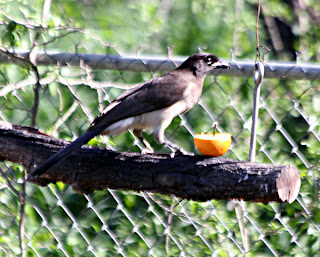After a muggy night at Goose Island in Rockport, TX, we are up early having coffee in the Airstream. The air conditioner quit last night, probably from over-heating. There are strong thunderstorms forecast all day and one cell just hit, as I was planning to take the dog for a walk.
So we are lying here with the rain hammering the aluminum cylinder we call home and our dog has her anxiety-easing Thundershirt on – lying at the foot of the bed in spite of thunder and lightening. And I’m thinking about migrating birds.

As birders, we were talking yesterday about the forecast with hopes that tomorrow would deposit some tired migrants here – a so-called fallout where tired birds stop and rest after crossing the Gulf. Here’s a description from Houston Audubon:
Many species of birds, called neotropical migrants, nest in North America and spend the winter in Latin America. Twice each year these birds migrate the long distances between wintering grounds and spring nesting locations. Each spring millions of birds that wintered in Central and South America are driven north by the urge to establish breeding territories and select mates. They first push north to the Yucatan Peninsula and the adjacent Mexican coast.
Beginning in early March, migrants reach the tip of the peninsula and if the weather conditions are favorable, just after sunset, migrants leave Mexico and head north across the Gulf of Mexico. The trip across the Gulf is 600 miles and with good weather takes about 18 hours. Arriving on the Texas coast midday, some of these birds stop on the coast; but most will fly inland until nightfall.

During the spring migration period from early March to mid May conditions occasionally exist where strong, turbulent north winds and rain trigger a phenomenon called a “fallout.” This usually happens when a strong, fast-moving cold front crosses the Texas coast and moves into the Gulf of Mexico during the middle of the day. The wind and rain slows the migrating birds down causing them to rapidly use up their stored energy reserves. Thousands of extremely tired migrants are forced to seek shelter and food as soon as they reach the coast. At these times, good-quality habitat along the coast is vitally important to the survival of tens and thousands of birds.
The folks at Woodcreeper.com, who track migration radar images, posted the one above saying that “Birds are slamming right into the storm.”
So, as I lie here listening to heavy rain and feel the wind, I’m thinking about those thousands of warblers flying in the dark, getting hammered by this violent series of storms. While it would be great to see a bunch here in the morning there’s a side of me that hopes they waited a day or two – and can make it in easier flying condtions.
It will make me appreciate the Black & White Warblers and their friends when I see them in New England later this Spring.
Cerulean Warber by Greg Lavaty






















